The best water filter jugs – as tested by experts
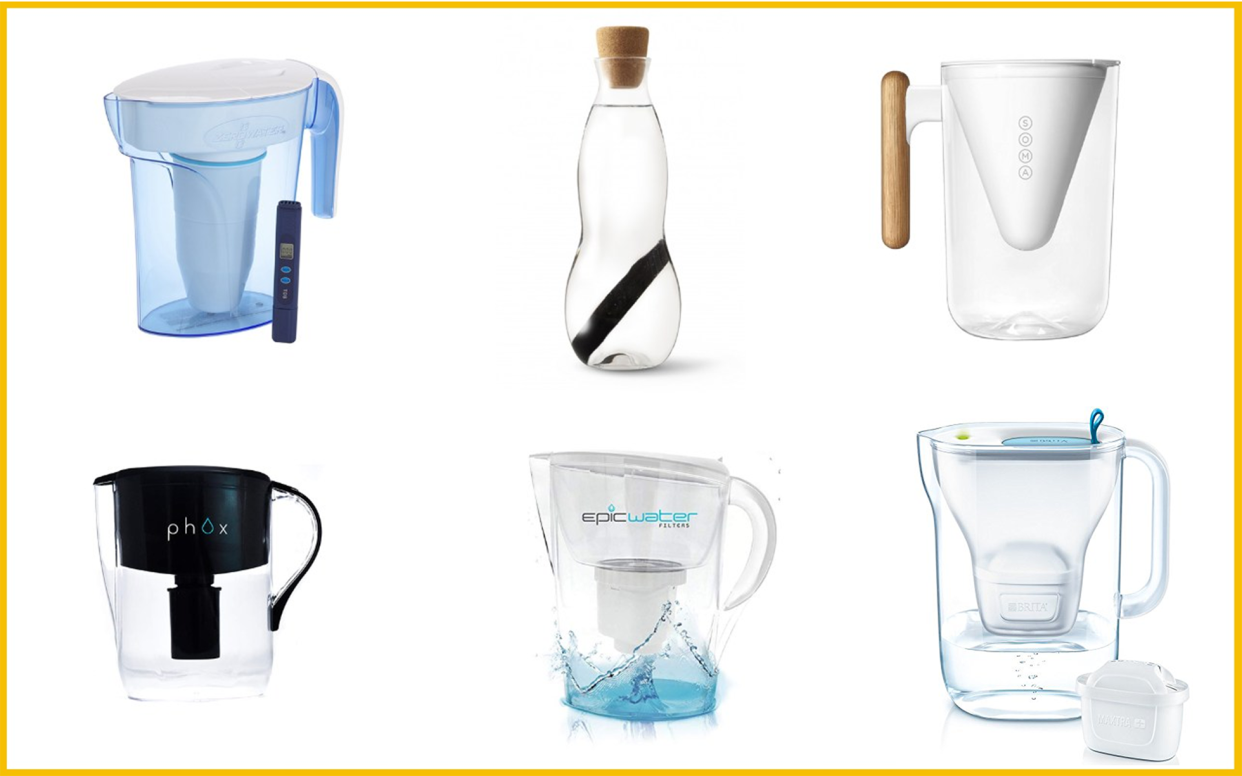
“Water is the new frontier,” says Dr Rita Palandri, a member of the UK Sommelier Association. Palandri is one of a small but increasing number of expert tasters who are preoccupied with the quality and flavour of H2O – that hydrating compound which makes up 60pc of the human body.
Yes, there really is such a thing as a water sommelier. In the US, water sommelier Martin Riese has made headlines by dreaming up a 44-page water pairing menu at Ray’s & Stark Bar, a restaurant at the Los Angeles Country Museum of Art. And it appears the trend is growing: take a look at water connoisseur website finewaters.com and you quickly learn that there is a blossoming community dedicated to learning about the natural elixir that makes its way from mountains to mouths.
Now, if all this sounds somewhat 'out there' to you, then you're not alone: I confess I did a double take when I started researching the world of water tasting for this article. But as I sit around a big table full of colourless glasses, ready to embark on a test to find the best water filter jugs on the market, the experts assure me that this is serious stuff. "Water has a terroir, like wine, and it can improve the epicurean experience,” says Dr Palandri, a member of The Fine Water Academy. "The taste is determined by the minerals it contains."
Alex Wallace, head of quality control at Caravan Coffee Roasters, points out that this taste will have an effect on hot drinks too. Wallace, who grew up drinking Scottish water in the Cairngorms, says that the pH level (alkalinity or acidity) of tap water, plus its minerality and the total dissolved solids (TDS) it contains, will alter the flavour of your daily cup of coffee or tea.
Combine this with the drastic variation in tap water quality across the UK (Wallace says he was disgusted by London's limescale when he first moved to the city), and the fact that people are turning away from plastic-bottled mineral water, and you see why water filter jugs are an increasingly popular home solution.

Most water filter jugs are simply containers with built-in filters (which need to be replaced, depending on frequency of use). Some rely on activated charcoal for purification, while others are high-tech gadgets that come with their own TDS meter.
To find out the best on the market, we asked Dr Palandri, Wallace, and wine sommelier Andrea Rinaldi (president of the UK Sommelier Association) to test and review a range of filters, focusing on the products' ability to purify hard old London tap water (known for its distinctive chemical tang, apparently).
Before our tasters started, we analysed the tap water and found it to have a starting alkalinity of eight on the pH scale, and a TDS of 360. Both results are relatively high. A slight aroma and taste of chlorine was discernible.
"The ideal water, at least for coffee, should have a TDS of 80-200, a pH of 6-7 (so mildly acidic or neutral), not too much bicarbonate and no chlorine" says Wallace. "The water we’re starting with is claggy and thick, and leaves a patina on the tongue".
All the better to test with. Here's what we learned when putting this undesirable London tap water through different water filter jugs – starting with the ones that came out top...
BRITA Style filter jug
Why we like it: Simply the best water filter we tested, as agreed by all our panel

Brita is a brand synonymous with water filtering – and it turns out for good reason. While there are some serious contenders on the market worth checking out (see below for more), our tasters unanimously found this one to be the best.
The standard 2.4L version we tried fits happily in the fridge door. It has a total filtered water capacity of 1.4l, which is big enough for me, but large families might prefer the extra large version (at the time of writing, this is on sale at £22.19 from Amazon).
To my surprise, there's a definite difference in taste between the questionable London tap water and the water that emerges from the jug. Even I can taste it. “It has more of an all-round finish, a cleaner mouthfeel,” notes Wallace. “The water tastes neutral, rather than sweet or salty,” adds Dr Palandrani.
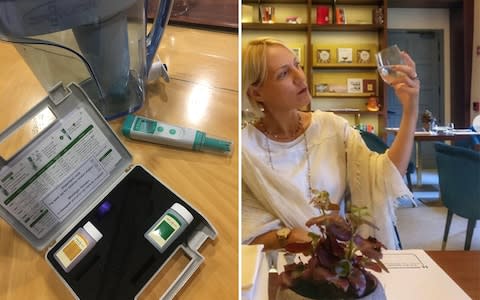
Our testing kit confirms that the water has changed, too. Post-filter, it's down to a TDS of 258 (from 360), so it has preserved some minerality while getting rid of the undesirable heavy chalkiness, limescale and chlorine common to London tap water. And – perhaps even more impressively – the water's pH is now a palatable 6.5 (down from 8).
For Palandrani, who prefers her water to be on the acidic end of the scale rather than the alkaline, it's a win. Wallace tells me it's perfect for coffee.
In fact, the Brita Marella is the filter that Wallace uses at home. While he professes his love for it, he notes that the filter cartridge does need replacing every four weeks if using frequently (£26.95 for a pack of six). Handily, it has a cartridge exchange indicator which informs you when you need to do so.
ZeroWater 7-cup water filter jug
Why we like it: The best filtration system we tried – perhaps even too good
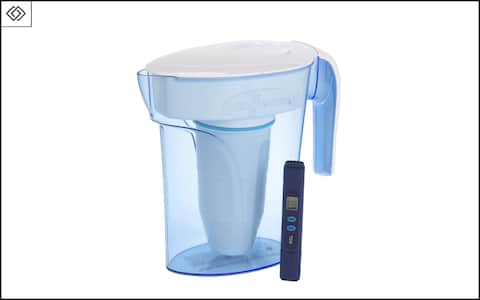
ZeroWater has some impressive claims to its name. It's the only water filter pitcher certified to reduce chromium 6 (the compound at the heart of the Erin Brockovich story), and spokeswoman Annette Lees tells me it removes microplastics down to three microns in size.
The 1.7L jug we try is designed for UK fridge doors, and offers “the purest drinking water on the market”. Such is its machismo that it promises to remove nearly all total dissolved solids, with an 99.6pc average purification rate. To prove the point, the jug even comes with a lab-grade TDS meter – although we decided to rely on our own meter to take a reading, for the sake of continuity.
Duly, our TDS reading showed that the ZeroWater filtration system reduced the amount of total dissolved solids in the tap water from 360 right down to just 10. It has little effect on the pH, however; the pH actually rose from 8 up to 8.1, according to our test.
The ZeroWater works quite slowly, gradually trapping solids in mesh sieves, passing the water through an activated carbon bed and then resin beads which exchange calcium and magnesium ions for sodium.
If total purity and softer-than-soft water is what you’re after, this might be the one. Our panel of experts judged the resulting water to be discernibly further forward in the mouth and slightly salty; fresher tasting, slippy and lighter; and they praised the lack of film coating left on the mouth. (According to Dr Paladrina, the lighter tasting the water, the better it pairs with lighter foods: salads and white fish, for example.)
However, despite the taste and the impressive filtering of pretty much all the dissolved solids in the water, Wallace voiced some reservations. “You need to retain a degree of minerality and at least some solids, for good coffee,” he says.
EpicWater filter jug
Why we like it: Long lasting filters make this good value for money

The Epic Water filter jug has the heftiest price tag of all – but does it meet expectations?
One of the reasons for that price tag is the fact that the filters last four times longer than Brita. Plus, the 3.5l jug promises to remove fluoride, lead, microorganisms, pesticides and chemicals.
The five-stage filter has specific filters geared to filtering out flouride and lead, while at the same time cleverly retaining calcium and magnesium. The technology is "smart" in terms of differentiating between “good” dissolved solids and “bad” dissolved solids. Bizarrely, our TDS test showed our rating of 360 rise to 375 – which may be a result of me not washing the filter properly beforehand, or of some dissolved solids present in the filter itself. The pH dropped slightly, to 7.8.
Either way, according to our water sommeliers, the resulting water was perfectly passable and a great improvement on the start water: it boasted the clean mouthfeel they were after, left no patina and boasted a very subtle sweetness.
The long list
Black & Blum Eau Carafe with charcoal filter
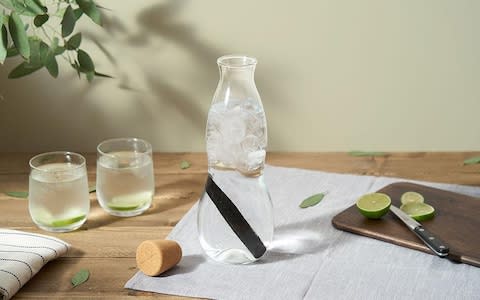
This beautifully-shaped plastic-free carafe by Black & Blum is currently cropping up on hipster coffee tables across the land. The natural cork is sourced sustainably, and the hand-blown glass is BPA-free. It's designed to house a Binchotan charcoal filter (which looks like a chunky black stick), as the purifying mechanism. You can buy a set of three replacement or additional charcoal filters for £18.99 on Amazon.
Our panel liked the fact that this is a glass alternative to the usual plastic filter. "Water that is housed in plastic can inevitably absorb some of that distinctive plastic taste, which lingers in the mouth. Glass can keep water cooler and purer, because it's a non-porous material," says Wallace.
"Glass is the best storage container for maintaining the purity of the water, plus its more sustainable – I personally don’t like Tetrapak-style plastic because I can taste it," says Palandrani. "And I do like the new trend for cold water sold in aluminium cans, but it tastes a little more bitter than normal."
The charcoal does the trick of absorbing the unwanted tastes and odours, such as chlorine, in my London tap water – and its presence certainly encourages me to drink more water. However, the TDS didn't change drastically enough to convince me that it was really working.
That said, you can taste the difference after an hour, and even more so after eight hours – which is fine if you're into "slow living", but it means it takes a lot longer to work its magic than the filters outlined above. As a result, it lost points for efficiency.
"Charcoal is believed to be an ecological alternative to other water filters, and I think this does improve the taste of tap water because it removes chlorine very effectively. However, you have to be careful as it doesn’t remove metals or bacteria; it’s just a matter of taste," explains Palandrani.
Soma 6-cup water filter pitcher
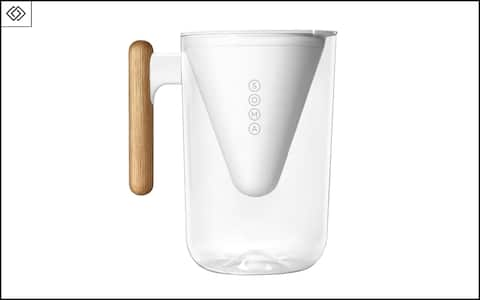
A clean, bamboo-handled aesthetic and fresh-tasting water to match. I like the 6-cup 1.35L model, but they also do a larger 10-cup design (£49, John Lewis) and a rather lovely 6-cup carafe (£59, John Lewis), which looks wonderful on the dinner table.
It promises to filter out the usual suspects: mercury, copper, chlorine, unpleasant tastes and odours, and zinc. It scores high on sustainability, too, since it's made from 65pc plant based and renewable materials – which means a lower carbon footprint.
"This water is light and fresh, and slips directly to the stomach without sitting heavily," says Palandrani. But Alex Wallace isn't so sure: "The resulting water has a TDS of 350 and a pH 7.5, so it's really similar and barely filtered. The claggy, drying finish of the tap water is gone and the mouthfeel is smoother, however, chlorine notes are still there."
"A pH like this, around 7, is fine for pairing with food but ideally, I prefer a slightly more acidic, lower pH for a glass of water," says Palandrani (scroll down for tips on pairing water and food).
Phox alkaline water filter jug
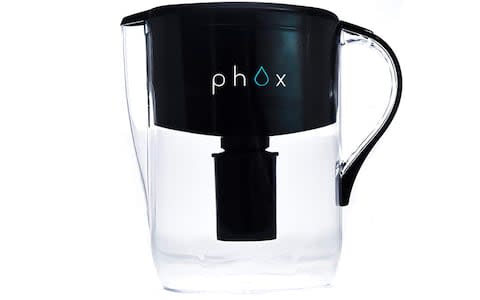
"Most water filters aim solely on removing contaminants and hardness from tap water," says Scott Dickson of British water filtering brand Phox. "This process removes the nasties and some of the goodies by mistake. The end result of the standard water filter is cleaner water but with less mineral content. This leaves the water slightly more acidic, since the alkaline minerals and electrolytes have been filtered out."
Enter Phox, which is designed with alkalinity in mind (it even comes with pH testing drops, in case you fancy yourself as a scientist). It looks stylish, so it gets top marks for aesthetics. It has a five-stage filtration process, and adds extra electrolytes to your water (these important minerals need replenishing in the body, particularly after exercise).
Theses added electrolytes mean that the TDS reading increases – but although hydrating, they are ionic solutions which cause the water to catch at the back of the throat and become a little too salty for our panel. Duly, our pH reading finds that the water becomes more alkaline, as promised.
However, our expert Alex Wallace isn't so convinced that this is a good thing. "Increased alkalinity means that water can begin to taste dull, and you lose any sparkle on the tongue. In coffee, a slight acidity gives you a brighter taste."
"The result shows an increased TDS of 373 and an alkaline pH of 8.9. It's visually a little cloudier and discernibly more alkaline - it's very slippery in the mouth but still has a lot of weight in the body, the taste is salty/umami. We all tried this in the roastery and we definitely thought it was a little weird in coffee."
Dr Rita Palandrani is on the fence: "Some people like alkaline water like this because it tastes distinctively soft in the mouth, a little chalkier than more acidic water. Others believe in the the alkaline diet and think its good for your health but it's not proven. If you subscribe to that, this jug works well."
Water filter jug FAQ
What's the difference between soft and hard water?
Hard water contains a high level of dissolved minerals. Hard water is often high in calcium and magnesium, bicarbonates which you can taste and which stop the water flowing so easily around the mouth. It’s alkaline, and tends to taste chalky and heavy. This is something that the water filters above can really help with, says Palandrani.
Hard water is known for making skin and hair appear brittle and dull (hairdressers have found themselves in hot water in the past for suggesting clients wash their hair with bottled water to avoid this. Personally, I prefer Diana Vreeland’s alternative suggestion that you use flat champagne in order to maintain shiny locks!).
“Soft” water, meanwhile, is low in calcium and magnesium, and the main ion is sodium (as a result, it can sometimes taste salty). Generally, soft water is more desirable, which is why so many people invest in water softeners.
What’s the best kind of water for making coffee?
“Water for coffee should be very soft by tap water standards, be slightly on the acidic side (so less alkalinity), some degree of minerality, be free of odours, have a neutral taste and be free of chlorine," recommends Wallace.
"Water that’s too alkaline buffers out the acidity, which is what gives you brightness and liveliness, and it just becomes flat and chalky."
How do you conduct a water tasting?
"Water tasting is very similar to wine tasting," says Dr Rita Palandrani. "But before pouring, it’s advisable to check the mineral content if possible. Pour it, observe it to check there’s no residues (it should be transparent), then you smell it, and then you taste it – more or less the same.
"It is better to use proper stemware, such as wine glasses, because it won’t interfere with the temperature, and it enhances the experience. It also means that your body heat from your hands doesn't affect the temperature of the water.
"The temperature is down to personal preference – some people like it cold from the fridge, others at room temperature. For me, still water is best stored and served at a consistent 13 degrees. If it’s too cold you can’t feel the content of the water, and it numbs the mouth.
"The air interacts with the water so make sure it has been stored in a sealed container. Glass is the best storage container for maintaining the purity of the water.
"Avoid ice, unless its made from the same water. It's good to know the provenance of your ice, in any case.
"Bold sparkling water, with violent bubbles, should be served a little warmer to calm it, at about 16 degrees. You can store it at 13 degrees like wine in cellars."
A word of caution: according to Wallace, if you fancy conducting a water tasting of your own, you should try and avoid spicy food and alcohol for a couple of days beforehand. It’s said to be particularly difficult if your palette is dulled.
“Like wine, tasting water is very personal," says Dr Rita Palandri. "Some people like to taste something in the water, others prefer it to be very pure and light. An aroma isn’t usually desirable, and water is often odourless, but some people do even enjoy a sulphurous aroma."
"Vichy Catalan from the Spa of Vichy in Catalonia has a discernibly high mineral content, and some mineral waters from Eastern Europe have an incredibly high TDS of up to 30,000, and can be very salty and heavy, and naturally sparkling. This makes them very interesting to pair with foods. I personally prefer bubbles, rather than plain, light, neutral water with no taste at all. An example of that kind would be Svalbarði’s polar iceberg water."
Which, by the way, will set you back €74.95 for a 750ml bottle. Best stick to the filtered tap water, I reckon.
How do you pair water with food?
According to Paladrina, the lighter tasting the water, the better it pairs with lighter foods: salads and white fish, for example.
She tells me that when pairing water with cheese, you need bubbles and minerality to cut through it. "Heavier waters cleanse the palette from greasy food, like duck," she says.
According to Fine Waters, you should progression of waters to guide you through the meal. "Drinking a different water for each course highlights their subtle differences, and the progression adds enormously to the dining experience," it states.
For a five-course dinner, it recommends that a good water progression might look like this:
Hors d'oeuvre: Bold. This is much like having a taste of champagne - it draws attention and is bubbly and loud.
Salad: Effervescent. A nice contrast with the previous water but not entirely without bubbles.
First course (light seafood, for example): Still. You will notice the absence of bubbles and focus on the water.
Second course (poultry, for example): Reintroduce some mouthfeel and match the water with the texture of the course.
Main course (red meat, for example): Heavier, to match the texture of the course.
Dessert: Still.
Coffee experts Caravan Coffee Roasters will open the doors to a new stand-alone roastery in Islington in late 2018. It is expected to roast nearly 200,000 worth of coffee every day, and will be combined with a coffee education studio, a brew bar and a café.


 Yahoo News
Yahoo News 
